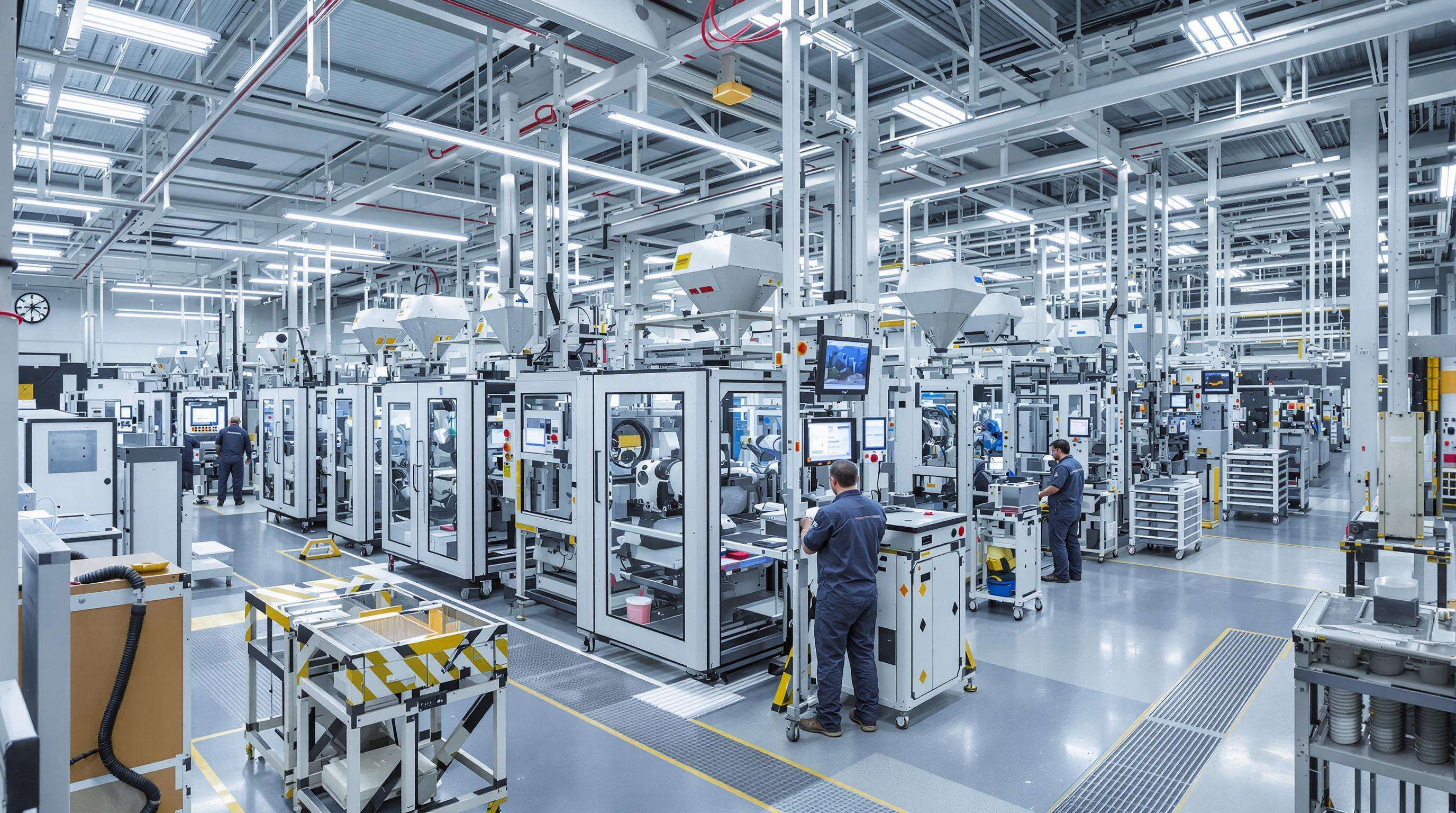Three factors are driving blow molder penetration of automotive: pressure to lighten vehicle due to regulations, the cost-performance advantage over metal working and the increasing scaling up of electric-vehicle (EV) production. As automotive manufacturers are working to cut vehicle weight by 10%–15% in order to meet 2025 emissions targets, plastic fuel tanks, air ducts, and fluid reservoirs have taken over from the metal fuel tanks, air ducts, and fluid reservoirs that used to comprise 30% of mid-range sedans. This transition allows for a saving of 80–120 kg per vehicle, which can be upheld through crash safety by the use of modern polymer blends.
The ongoing EV revolution is also driving demand, with battery enclosures and thermal management systems demanding lightweight corrosion-resistant plastic geometries that cannot be produced with injection molding. According to a 2024 poll 78% of EV platforms incorporate blowmolded parts in battery cooling lines and HVAC assemblies. Material breakthroughs such as 35% glass-fiber-reinforced PET make these parts capable of handling increased temperatures in excess of 200°C and 40% weight-savings over aluminum counterparts.
Cost dynamics equally drive adoption. Blow molding’s per-part costs are $1.20–$4.50 for high volume parts compared to $8–$15 for metal stamped alternatives with 60% less mold tooling costs. Suppliers are capitalizing on these economics to pursue multi-region production strategies—18 of the top 20 automotive suppliers now have synchronized blow molding operations in North America, Europe, or Asia to reduce logistics expenses.

Cost-effective blow molding can only be achieved by controlling material use, cycle time, and energy use with precision. The standardization of these pillars enables manufacturers to scale-up and retain part-integrity. Industry analysis indicates that when plants implement these systems together (as opposed to separately) costs decrease 18-27%. The approach turns single operations into well-integrated production networks based on three fundamental approaches.
Accurate parison programming reduces resin loss during extrusion and ensures consistent wall thicknesses. Improved algorithms adapt the distribution of material to the geometry of the mold with reductions in scrap of 15-22% in batch operations. (According to the function of the part) 25-40% calibrated level of incorporated recycled polymers maintains structural specifications while bringing down the cost of the input raw material. Finite element analysis for light weight savings is an additional way to save in energy without compromise in performance crash test regulations.
Turbulent water-throw out system decreases solidification stages by 30-40 seconds per cycle. Dual ejection and clamping action reduces downtime on larger parts such as ductwork or tanks. Not to forget, automated in-mold trimming operations connect directly into conveyor systems and deliver 97% uptime on continuous production run times. The extrusion parameters are automatically adjusted in real-time as part of the viscosity monitoring control so that rejects can be avoided without stopping the line.
ISO 50001 standard frameworks harmonize motor and heater operation across multi-plant networks. Servo-hydraulic hybrids lower power consumption 45-60% versus hydraulic systems when molding at reduced power levels (non-peak). Thermal imaging audits will reveal insulation gaps in barrels, significantly reducing standby energy losses. Plant-wide heat recovery systems recapture waste energy for secondary processes, which have contributed to a 35% improvement in per-part kWh use, since 2022.

The challenge of consistent quality can varies from on blow molder operation to another occur among blow molders operating in different geographic regions. Meanwhile, environmental factors such as the temperature and moisture change the viscosity of the material, resulting in different wall thicknesses and structural defects. Lack of unified measuring methods and calibrated inspection apparatus can cause 18–22% increased scrap rates. Such QA mentality provides realtime anomaly detection on digital QA systems with integrated defect classification framework. However, heterogeneous regional certification conditions make the calibration of threshold values complicated, where we need machine learning models to normalize quality index (QI) indicators while considering the local constraints.
Synchronization of the material flow plan and mold assignment plan, and maintenance arrangements for such an operation across a number of plants, adds complexity to bottlenecks. Plant-to-plant shipping has been delayed, which then derails just-in-time resin delivery and customs add 30 to 45 days to the lead time on tooling moving between plants. Centralized resource planning tools alleviate these challenges with such transparency into equipment utilisation rates and predictive maintenance logs. Another barrier to standardization is cross-regional gaps in labor skills— one group of technicians who specialize in mold adjustments, for example, may perform changeovers differently than another group of technicians. Proactive operator training with VRS is your gateway to closing competency gaps, lowering set-up variability by 27% in comparative studies.
Blowmolding operations are under increasing demands for cost-effective production and enhanced part performance. This paradox is a result of competing requirements for lower material usage and cycle times, and for structural integrity in a wide range of automotive applications. There are three important tradeoffs that are required to be forced for a manufacturer to balance between economical feasibility and technical specifications.
Optimizing wall thickness remains a central challenge, as 0.2mm reductions can decrease material costs by 18% while potentially compromising impact resistance. Advanced flow simulation software now enables engineers to predict stress concentrations in complex geometries, allowing precise thickness calibration. Recent field data shows:
| Thickness Range | Defect Rate % | Weight Savings % |
|---|---|---|
| 2.5-3.0mm | 2.1 | 0 |
| 2.0-2.4mm | 5.8 | 12 |
| 1.5-1.9mm | 15.4 | 27 |
Source: 2024 Automotive Components Durability Report
While robotic tending systems reduce labor costs by 34% in high-volume scenarios, their ROI plummets below 50,000 annual units. A 2023 SME survey revealed 68% of manufacturers postpone automation due to:
Modular automation architectures now enable gradual implementation, with standardized end-effectors cutting redeployment costs by 60% compared to bespoke solutions.
This centralized facility monitoring system allows for real-time monitoring of blow molding operations at multiple facilities. When IoT-driven sensors are connected with cloud-based analytics, manufacturers can realize 15–20% faster anomaly detection compared to siloed systems. This application allows a global control of pressure, temperature and cycle time as well as a local control of pressure, temperature and cycle of material viscosity. It provides operators with single screen monitoring of deviations over ±2.5 percent from baseline KPI performance, allowing proactive intervention without breaching quality limits.
Effective knowledge sharing across distributed plants relies on three pillars:
A 2024 cross-industry study found organizations with structured knowledge-sharing protocols reduced scrap rates by 18% during new product launches compared to facilities operating in isolation.
Modular mold systems achieve 40–60% faster changeovers through:
These protocols reduced mean changeover duration from 78 minutes to 32 minutes in multi-plant trials, enabling smaller batch economics without sacrificing OEE (Overall Equipment Effectiveness).
Consolidated raw material purchasing across 8+ facilities typically yields 12–15% volume discounts on polymer resins. Centralized qualification programs enforce:
This approach reduced material-related downtime by 23% in multi-year implementations while maintaining AS9100 aerospace certification standards across all participating plants.
Blow molding is a manufacturing process used to produce hollow plastic parts by inflating a heated plastic tube until it forms the shape of a mold.
Blow molding is favored in automotive production for its lightweight properties and cost advantages compared to traditional metalworking methods.
Blow molding contributes to electric vehicle production by providing lightweight, corrosion-resistant parts necessary for battery enclosures and thermal management systems.
 Hot News
Hot News2024-10-29
2024-09-02
2024-09-02

Copyright © 2024 Changzhou Pengheng Auto parts Co., LTD